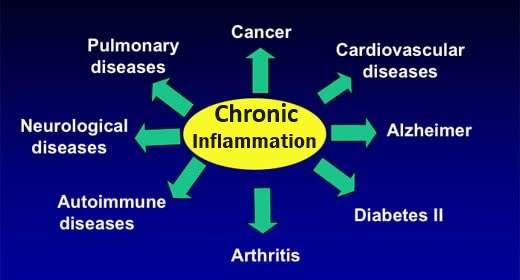GSE
Cardiovascular /Heart disease / Atherosclerosis - What injures arterial lining?
What injures arterial lining?
Damage to the arterial
lining can be inflicted by several mechanisms, irritating /inflaming the
arterial lining (endothelium) and
causing an inflammatory response. The offending culprits
include:
Blood flowing under high
pressure generates fluid shear-stresses at each heartbeat - which can damage areas leaving the heart,
usually where the blood vessels are stretched and bent
Damage does not occur
in random locations
- Veins
(which are under 8 times less pressure than arteries) do
not have atherosclerosis.
- Pulmonary arteries generally don't
develop atherosclerosis. Having 1/5 of body's systemic
pressures
- Damage occurs in regions of high
pressure, branching and marked curvature, at areas of geometric irregularity.
Where blood undergoes turbulent changes in velocity and direction of flow;
Increased blood press ure
c an be due to emotional stress, or
progressing atherosclerosis.
Oxidant
/Antioxidant Imbalance
Oxidative metabolism is designed
to extract energy by controlled oxidation of substrates and, at the same time,
to prevent uncontrolled oxidative damage via
antioxidants . A good analogy is "to use fire for warmth, but to not get burnt".
A major reason your arteries are incurring
damage, is because too many highly reactive, oxidant
ions/molecules
being produced in the
body, have overwhelmed the body's
antioxidant
presence. Uncontrolled
free radicals ,
ROS
(Reactive Oxygen Species), RNS
(Reactive Nitrogen Species)
and other reactive species
are likely to take part in chemical reactions with your body's proteins,
lipids, carbohydrates and DNA.
For more detailed information on
Reactive Oxygen Species (ROS) :
Life's Oxygen Paradox - Meet Dr.
ROS
Jeckyll and Mr.
ROS
Hyde
Where are reactive
Oxidants coming
from?
(high blood sugar) increases damaging AGEs
Glycation of sugar molecules lead to Advanced
Glycation Endproducts (AGEs),
some of which are implicated in age-related chronic diseases including CVD.
In
addition to oxidation, another mechanism causing significant damage and
inflammation is glycation. This is the haphazard process (without
adding sugar molecules to lipid
molecules or proteins, to form a
glycolipid or glycoprotein, and harmful by-products, aptly called AGEs (Advanced
Glycation Endproducts).
AGEs can be formed
outside or inside of the body:
Exogenously. AGEs are
typically formed when sugars are cooked with proteins or fats. Food
manufacturers add AGEs to foods as flavor enhancers and colorants to improve
appearance.Endogenously. Glycations occur mainly in the bloodstream to some of the absorbed simple
sugars, i.e. glucose, fructose and galactose.
AGEs can directly damage the endothelium and other biomolecules,
including connective tissue collagen, elastin and fibrinogen in the blood vessel
walls, and so weaken the arterial wall
Fructose and galactose
have about 10 TIMES the glycation activity of glucose
(Bunn and Higgins, 1981) High
fructose corn syrup is commonly used in many processed foods, fructose
has become an excessive
component in today's Western diet;
Cholesterol and Fat is
Damaged by Glycation - Increased amount and duration of glucose in
the blood allows more glycation to occur, inflicting damage on tissues via lipid
oxidation (Bucal etal, 1993)
Hyperglycemia increases
glyco-oxidation, which increases the formation of oxidized LDL, and its
accumulation in the artery wall - and is positively correlated with arterial
disease in many diverse populations.
Glucose and
fructose glycate and inactivate the enzyme
glutathione reductase, responsible for maintaining the body's major
cell-protecting antioxidant enzyme
Glutathione (GSH)
- Glucose, glucose 6-phosphate and fructose all
displayed a time-dependent inhibition of glutathione reductase activity,
suggesting that these sugars glycate this enzyme. (Blakytny and Harding, 1992)
Circulating AGEs bind
LDL cholesterol and increase its accumulation in arterial wall -glycation of LDL cholesterol increases the proportion of lipoproteins
that are taken up via inflammatory cellsand decreases the
proportion taken up by liver cells (hepatocytes) via classical LDL
receptors, thus contributing to atherosclerosis by increasing accumulation of
LDL cholesterol in the artery wall.
- Glycated sugar creates inflammation,
which activates defensive immune system macrophages -
scavenger cells with special receptors for AGEs, called RAGEs (again how aptly
named) that bind to the AGEs to remove them.
(d)
Homocysteine is a by-product of
normal metabolism of the amino acid methionine - abundant in
red meat, milk and its products.
- Its levels increase
with certain nutrient deficiencies - especially a
deficiency of the B-vitamins.
- High levels of
homocysteine correlate to greater arterial tissue damage leading to
atherosclerotic plaque growth - It is theorized that homocysteine produces oxysterols (oxygenated
derivatives of cholesterol), which cause cholesterol oxidation.
An overly-acid diet is generally the result of:
▲
Dehydration
▲
Eating more
meat and dairy, less fruit and vegetables
▲
Eating more cooked food than raw;
When blood is less alkaline than is ideal, it can
act as an irritant to the arteries;
Acid / Alkaline Balance
References
Blakytny R, Harding JJ (1992) Biochem J, Glycation (non-enzymic
glycosylation) inactivates glutathione reductase
Bucal R et al (1993) Lipid advanced
glycosylation: pathway for lipid oxidation in vivo
Bunn HF, Higgins PJ (1981) Reaction of monosaccharides with proteins: possible
evolutionary significance. Science 213:222-4

